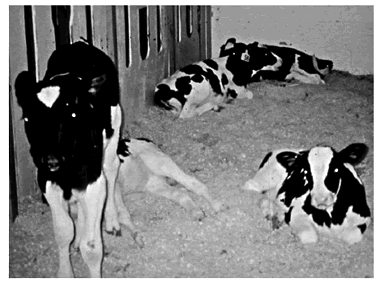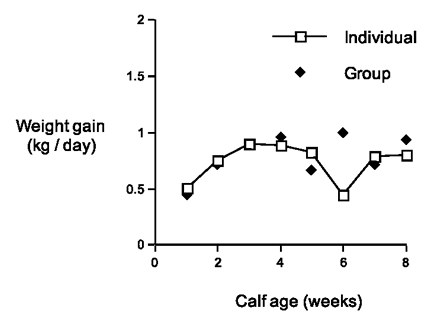Dan Weary
Dairy cattle are naturally group-living animals, and almost all aspects of modern dairy production systems are based on keeping cattle in groups. This raises the questions; why are young calves normally housed in individual pens or hutches from birth until weaning, and if the calves were kept in groups, what would be the potential advantages and disadvantages? The aim of this Research Report is to describe some positive aspects of group rearing, especially associated with improved calf feeding methods, as well as some of the potential pitfalls.
Challenges of calf rearing
Caring for the milk-fed calf is one of the most challenging aspects of dairy production. At no other stage of life are our animals so vulnerable to disease, and far too many calves fail to survive until weaning. However, many dairymen are able to achieve very high levels of calf health by following several key practices including: 1) ensuring that all calves receive generous amounts of high-quality colostrum within the first few hours after birth, 2) providing that they have free access to clean water, 3) making sure they receive a high quality and quantity of milk from a clean feeding system, and 4) providing the calves with a clean, dry and well-bedded resting area, protected from drafts but with good air quality. Farm bio-security procedures, like keeping a closed herd and ensuring that boots and equipment from other farms are properly washed before arrival on your property, can be used to further prevent the spread of diseases. In situations with frequent outbreaks of disease, the factors listed above should be considered before attempting group housing, which may otherwise simply increase the spread of disease among the calves.
However, for those producers with excellent calf management procedures in place and a good record of calf health, group housing may provide further advantages for both the calves and those who care for them.
Why keep calves in groups?
Group rearing allows for early social interactions that have been shown to be important in the development of normal social responses later in life. Group housing provides improved access to space, allowing for more vigorous activity and play. Grouping calves also reduces the labor associated with cleaning calf pens and calf feeding.

Figure 1. Housing calves in small groups can provide advantages over individual housing, but is only recommended for good calf managers.
Despite these apparent advantages of group housing, North American dairy calves are typically housed in individual pens or calf hutches, in part due to concerns about reduced weight gains, increased incidence of disease, and behavioral problems such as cross-sucking. Research in now showing that for a well-managed calf unit these problems can be avoided.
Feeding calves more milk
When calves are fed limited amounts of milk by bucket, as in conventional practice, calves remain highly motivated to suck, and will spend time sucking on anything available especially during the first half hour after each milk meal. When housed alone, calves will suck on pen fixtures such as the empty milk bucket, but if kept in groups calves fed this way will often suck each other, sometimes leading to injury. The good news is that this abnormal behaviour can easily be prevented by feeding calves in a more natural manner.
The advantages of feeding calves more milk are becoming widely recognized, in part because of UBC research on this topic (see Research Reports “Feeding Calves More Milk”, Vol. 2, No.4). We also recommend providing this milk from a teat to encourage more natural drinking behaviour. Calves fed this way spend about three-quarters of an hour drinking milk each day, compared to just a minute or two when limit fed (4-6 litres per day) from a bucket. This also provides a natural outlet for the calves sucking behaviour, and essentially eliminates sucking on fixtures, or other calves. Thus feeding calves more milk and using a teat to deliver the milk can address problems with cross-sucking, but what about calf health and performance?
Growth rates of group housed calves
In a recent study at the UBC Dairy Research and Education Centre in Agassiz, we showed that calves could be reared in small groups with excellent health and rates of growth. In this study, we created ‘group’ pens by simply removing partitions between pairs of conventional pens to create space for two calves. Half of the pens in the calf barn were kept as individual pens for comparison, and all calves were provided with free access to milk by teat. Calves were gradually weaned at approximately 5 weeks of age and remained on the experiment until 8 weeks old.
As illustrated in Figure 2, calves gained weight steadily with no differences between treatments. During the week of weaning, pair-housed calves continued to gain weight normally but the individually housed calves experienced a slight growth check. There were no differences between groups in the amounts of milk, starter or hay consumed, or in the incidence of scouring or other disease. Aggressive behaviour and cross-sucking were almost never observed. These results show that dairy calves can indeed be reared successfully using small groups.

Figure 2. Weight gains of calves housed in either individual pens or as a pair.
For the past 2 years we have reared all calves at the UBC Dairy Centre in small groups (usually about 5 calves per group) as part of our standard procedures, and this method continues to work well for us.
With funding from Dairy Farmers of Canada we are also pursuing new research on how to further improve management and housing for group-housed calves fed in this way. In one new project we are working with automated calf feeders, specifically designed to manage the feeding of calves kept in groups. Watch for future Research Reports for updates on this research about improved methods of housing and managing the young dairy calf.
To find out more about recent work on dairy calf rearing and other topics, please visit the UBC Dairy Centre.
Thanks to the dairy industry for their support of this research through funding to the Animal Welfare Program by the Dairy Farmers of Canada, the BC Dairy Foundation, BC Milk Producers Assn, Westgen, and many others listed on our web site.
This article is based on research by graduate students Bev Chua, Eveline Coenen, and Joyce van Delen. Dan Weary is a Professor in UBC’s Animal Welfare Program.
